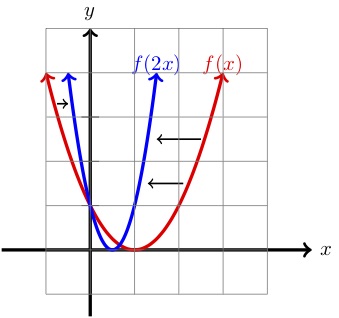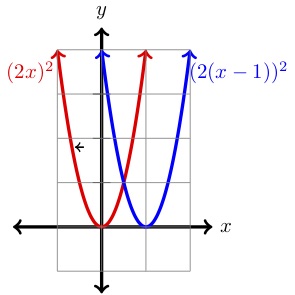Supplemental Videos
The main topics of this section are also presented in the following videos:
The main topics of this section are also presented in the following videos:
Nearing the end of this chapter, we have now discussed several transformations which can be performed on a function. Since we now have a solid grasp on each of these transformations, let's apply multiple transformations to a function and study the outcome.
Consider \(f(x)=(x-1)^2\text{.}\) We know from a previous section that the graph of \(f(x)\) is the graph of \(x^2\) shifted \(1\) unit to the right. 
The function \(f(2x)=(2x-1)^2\) should really be thought of as \(f(2x)=(2(x-\frac{1}{2}))^2\) and is the result of starting with \(x^2\) and applying
in this order.

As discussed thus far, in general, the order is important with transformations. However, if the transformations are vertical and horizontal changes then it does not matter whether the horizontal or vertical transformations are handled first. In general, we can follow the following guide:
Suppose that \(f(x)\) is our function we are applying transformations to. Once written in the form
the order of transformations is:
Describe the function
as a list of transformations done to \(f(x)\) in the appropriate order.
First, let's rewrite the function in the form given above: \begin{align*} 5\cdot \Big(f(-3x-6)-1\Big)\amp = 5f(-3x-6)-5 \ \ \text{we distributed in the 5}\\ \amp = 5f\big(-3(x+2)\big)-5 \ \ \text{we factored out the -3} \end{align*} Now that the function is written in the desired order, we may list off the transformations in the correct order using the order discussed above: